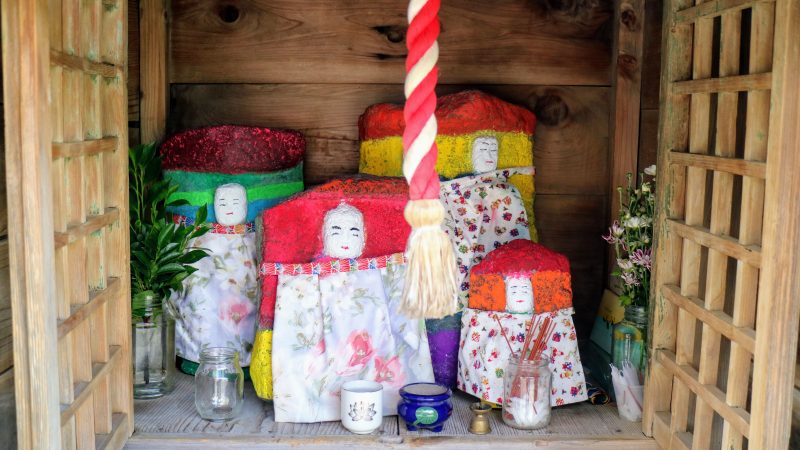Hand-painted Jizo statues in Obama, Fukui Prefecture. Photo by Nevin Thompson.
If you’re interested in learning more about some of the more offbeat folk traditions of Japan, the Twitter account Unusual Festivals of Japan Club, (or ‘KFC’ for short; the ‘K’ in the acronym stands for 奇祭, kisai, or ‘unusual’) is a must-read. Tweeting multiple times a day, KFC documents the myriad local traditions of Japan, some of which date back more than a thousand years.
In this festival occurring on the remote Noto Peninsula, inebriated men haul around gigantic portable shrines to mark the end of the harvest.
奇祭過去レポ・石川県七尾市の久麻加夫都阿良加志比古神社の毎年9月20日に開催される、「お熊甲祭り」を訪問。『枠旗』という高さ20m重さ1tにもなるのぼりをサルタヒコが導き、男たちが威勢をあげながら社殿に一気に駆け上がる姿が圧巻でした!pic.twitter.com/dPW9yknEK2
— 奇祭ファン倶楽部(KFC) (@clubkisai) May 4, 2018
Each year on September 20, Kumakabuto Arakashihiko Shrine in Nanao, Ishikawa holds the ‘Okuma Kabuto’ festival. Portable shrines weighing 1 tonne with 20-meter flagpoles called ‘wakuhato’ bear Sarutahiko Okami (one of the ‘six great kami’ of Shinto). The highlight of the day is watching the shrine-bears dash up the hill to deliver the god to the main Shrine hall.
Images of the festival, like many others that KFC documents, can be found on YouTube:
Another festival commemorates Sugawara no Michizane, a deity enshrined in Tenman-gu, a common shrine found in many parts of Japan. At this location in northern Japan, festival participants remember Sugawara no Michizane by drinking with their faces covered:
【山形・化けものまつり】<5月25日>鶴岡天満宮の天神祭。菅原道真が配流される時に道真を慕う人々が時の権力にはばかって顔を隠し、姿を変えて酒を酌み交わして惜しんだという言い伝えから、変装した人々が無言で酒やジュースを振る舞う。 pic.twitter.com/rBTKSR3yu1
— 奇祭ファン倶楽部(KFC) (@clubkisai) May 3, 2018
Yamagata ‘Beastly Festival’ (Bakemono no Matsuri, May 25 each year): Sugawara no Michizane festival, Tenman Shrine in Tsuruoka, Yamagata Prefecture. Following Sugawara no Michizane’s banishment (following court intrigue about 1,000 years ago), it’s said his followers, fearing being associated with him, disguised their faces when drinking together. In this festival, participants silently drink sake or juice as they dance.
Portable shrines, called mikoshi, play an important role in Japanese festivals. This festival in Uji, in Kyoto prefecture, features a mikoshi that transports Brahma-Deva, an important protective deity in Japanese Buddhism.
【京都・あがた祭り】<6月5日~6日未明>別名「暗闇の奇祭」。梵天とよばれる竹棒の先へ奉書を球状に束ねた祭具を乗せた神輿を男衆が担ぎ、激しい「ぶん回し」や左右前後に揺さぶる「差し上げ」をしながら町の深夜の暗闇の中を練り歩く。 pic.twitter.com/45dNhysKrl
— 奇祭ファン倶楽部(KFC) (@clubkisai) May 4, 2018
Kyoto Agata matsuri: Each year from June 5 to the end of the month (also known as the kurayami kisai, or ‘the dark rite’). Festival attendants transport a ‘Brahma-Deva’ (bonten, 梵天), bamboo pole with paper sphere that serves as a portable shrine. The attendants shake the pole from left to right as they walk all throughout the night.
The website Green Shinto, always a good source of information about Japanese folk traditions, explains what happens during the festival procession:
There were two floats, both borne on the shoulders of men in happi. One had a fierce looking shishsi (Chinese lion) and the men yelled ‘yoiya, yoiya’. The other represented Bonten, a kami protector of Buddhism represented by a pole with white paper streamers. (According to the shrine office at Agata Shrine, when the deity there is transferred to the float, it mutates into Bonten.) Here the men were shouting, ‘Washoi, washoi.’ As the float was carried around, one of the men stood on top and grasped the pole with one hand, his head buried in the paper streamers, with the other hand stretched out in protective manner […]
A short video of the festival can be found on YouTube:
Foxes play an important role in Japanese folklore. Inari, the fox god, is one of the most popular deities in Japan, representing good luck, good fortune and fecundity:
【山口・稲穂祭】<11月3日>花岡福徳稲荷社に祀られる狐が五穀豊穣・商売繁盛をもたらすとして「狐の嫁入り」が執り行われる。市民から夫婦役が選ばれ新婦役の女性は良縁に恵まれ縁結びの利益もあると言われるが、夫婦役が誰かは明かされない。 pic.twitter.com/NuTNfCxCjZ
— 奇祭ファン倶楽部(KFC) (@clubkisai) May 3, 2018
Yamaguchi Inari festival: Each year on November 3, a “fox’s wedding” (kitsune no yomeiri) is held for the fox (god) enshrined at Hanafukutoku Inari shrine, in hopes of a bumper crop and prosperity. Roles for the bride and groom are chosen from local residents, and those who play the bride are said to be a suitable candidate for marriage because of the auspiciousness of the event. However, the identity of the bride and the groom remains secret.
Some of the festivals KFC highlights are quite old. This festival in southern Nara prefecture dates back over one thousand years and has ties to the mountain worship of the region.
【奈良・蛙飛び】<7月7日>金峰山寺の蓮華会の一環の行事。修験道を軽んじて鷲にさらわれ、改心後悔しているところを高僧に蛙の姿に変えて救い出された男が法要が一段落した後に外陣に現れ、受戒導師の法力によって人間に立ち返る。 pic.twitter.com/BE2OKqqy8x
— 奇祭ファン倶楽部(KFC) (@clubkisai) April 30, 2018
Nara Jumping frog (kaeru tobi) festival, July 7: One of several annual events to commemorate the annual rengekai rite at Kimpusen temple in Nara. A man slandered a local deity and as a result, a great eagle hung him from a mountain crag. Finding the man and taking pity on him, a Kinpusen temple priest turned him into a frog so he could get down off of the crag, and then back into a human again.
This video provides a more detailed look at this festival devoted to jumping frogs.
The KFC Twitter account also highlights common folk traditions in rural Japan, such as “bull sumo” or bull wrestling.
【愛媛・宇和島闘牛大会】年に数回行われている。牛同士が相撲形式で角と角をつきあわせるタイマン勝負。番付表も作られている。時間無制限で行われ、戦意喪失して逃げた牛が負けとなる。負けた牛のほうへ慰めの意味を込めて多く給金が支払われる。 pic.twitter.com/9C7tm3UUoI
— 奇祭ファン倶楽部(KFC) (@clubkisai) April 20, 2018
Uwajima, Ehime bull sumo (ushi-zumo): Occurring several times a year, bulls face off in a sumo ring in a one-to-one competition. Bulls are ranked, and there is no time limit for matches. Bulls that lose spirit and attempt to run away are named the loser. In consolation, bulls who lose claim the prize money.
Another interesting folk tradition described by the KFC account is the old Okinawan practice of hajichi, or traditional tattoos.
【沖縄・ハジチ(針突)】かつて行われていた沖縄女性の風習。12、3歳ごろから大人の女性になった証、既婚の証として手の甲に刺青をほどこしていた。ハジチはオシャレであると同時に家族にとっては誇らしいことで、初めて入れた日はお祝いをした。 pic.twitter.com/Zw0VmZ4N5c
— 奇祭ファン倶楽部(KFC) (@clubkisai) April 21, 2018
Okinawa ‘Hachiji’: As part of a tradition maintained by women in Okinawa, in southwest Japan between the ages of 12 and thirteen, hands are tattooed to confirm passage into adulthood, as well (in later years) as proof of marriage. The tattoos were considered fashionable and chic, and the occasion of the first tattoo was commemorated with a family celebration.
The practice has vanished since the end of the Second World War, but Lex McClellan, writing on Medium, provides some interesting background on hachiji.
Another regional custom profiled by the KFC account is the practice of Yomeburi, which happens along the Japan Sea coast wherever buri, a fish commonly consumed in the winter months in Japan, is caught. The image in the tweet comes from the manga and anime series My Bride is a Mermaid (瀬戸の花嫁).
【富山・嫁ぶり】娘を嫁に出した年は年末にお歳暮として嫁いだ先の家へ婿の出世を願って出世魚のブリを送る。なるべく大きく、立派なものを届けるのが良いとされている。氷見漁港で水揚げされる氷見ぶりは醤油をはじくほど脂のノリが良い最高級品。 pic.twitter.com/Xmi4h6yFPh
— 奇祭ファン倶楽部(KFC) (@clubkisai) April 29, 2018
(Cartoon image shows a young woman with a fish for a face)
Toyama Yomeburi Festival: In this festival, when a daughter leaves home to become a wife, as a year-end gift the bride’s family sends a buri (a kind of jack fish) to the groom’s family, in hopes of success in life. The buri should be as large and grand as possible. At the fishing port in Himi, Toyama, it’s said the buri are so fatty that the fat repels soy sauce.
The KFC Twitter account posts about Japanese folk practices several times a day. While the tweets are almost always in Japanese, the images alone provide an intriguing glimpse into Japanese life.














